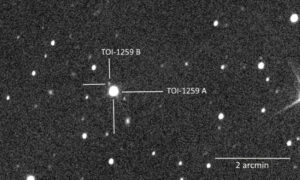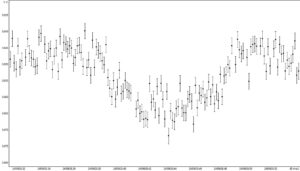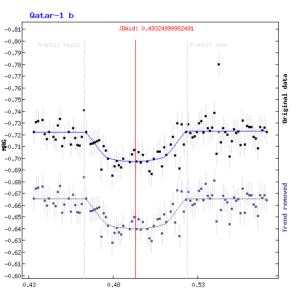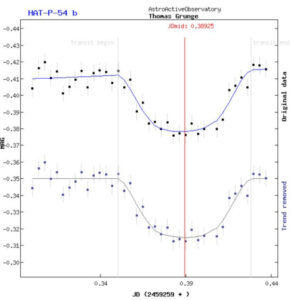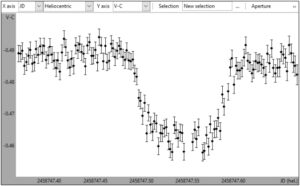
Exoplanets are planets that orbit other stars outside our solar system. Their discovery and research are of great importance. Amateurs can contribute to the study of exoplanets. For example, they can provide supplementary data by measuring the so-called transit light curves, in which the parent star is somewhat obscured by the planet moving in front of it, or by frequently determining the brightness and possible variability of the parent star. These data are used when measurements are to be carried out with extremely expensive telescopes, partly in space, which are previously dependent on certain parameters, e.g. precise timing.
To provide a better overview of the exoplanets observed by kosmos-os, we have created a map of the starry sky with the positions of the exoplanets for you.
- Measurement of the transit light curves of the exoplanets WASP-84b and KPS-1b on March 7 and 8, 2024The measurement of the transit light curves of the exoplanets WASP-84b and KPS-1b is described. The radius of the exoplanets is determined from the degree of “darkening” of the parent stars. The transit method makes this possible, although the two systems can only be observed as point sources of light.
- Measurement of the transit light curve of the exoplanet TOI 3952.01 on January 10, 2024The measurement of the transit light curve of the exoplanet TOI 3952.01, 1929 light years away, is described. It is a recently discovered exoplanet. The own measured data are compared with the few available literature values.
- Transit light curve of the exoplanet TOI-1259 A b on September 25th/26th, 2023The transit of the exoplanet TOI-1259 A b in front of its parent star, which is a component of a binary star system, is shown. The light curve recorded agrees well with the measurements of other authors. A detailed error analysis provides information on how to further improve this sensitive measurement method.
- Measurement of the Transit Lightcurve of Exoplanet TrES-3 bThe transit light curve of the exoplanet TrES-3 b was recorded and measured on May 27th and 28th 2023. The method used and the specific observation conditions are explained. The results are presented and discussed based on an evaluation in the international Exoplanet Transit Database (ETD). The own result is a contribution in the context of so-called citizen science for further exploration of exoplanets.
- "Just" discovered - Exoplanet TOI-1259 A bThe transit light curve of the exoplanet TOI-1259 A b, discovered just two years ago, was measured. The data determined agree well with literature values. It is a double star system, which is additionally interesting. The close position at the north celestial pole allows interesting further observations.
- "boundless vastness" @ HomeIn the constellation Draco you can find exoplanets that are particularly bright. They can therefore be easily photometrically analyzed with small apertures. The measurement of the transit light curve of the exoplanet Qatar-10b is described. It was discovered in 2019 and confirmed as such.
- The star HD189733 and its planet HD189733bUsing the star HD189733 and its exoplanet 189733b, it is shown that even with a relatively small instrument from an urban light-polluted area, interesting meaningful measurements of stellar rotation and planetary transit in front of its parent star can be carried out. In addition, the synopsis of the results of many amateur astronomers worldwide enables further insights.
- Exoplanet XO-2 N b at 27th February 2022Two sun-like stars (yellow dwarfs) orbit each other 486 light-years away in the constellation Lynx. Both stars, XO-2 N and XO-2 S, have a total of three exoplanets detected using the transit method. With amateur means, one of these exoplanets, XO-2 N b, could be detected on February 27, 2022 by a light curve.
- Hot Jupiter with an uncooled DSLRThe measurement of the light curve of the exoplanet Qatar-1 b with an uncooled DSLR camera is described. The challenge is to achieve a meaningful result despite the high noise.
- Light curve of the exoplanet HAT-P-54bThomas Grunge did not only take a picture in his garden, but a light curve of the exoplanet HAT-P-54b. This planet does not orbit around our sun, but around the star HAT-P-54, whose light has been on its way to us for 443 years. This planet can no longer be seen directly, but can only be detected when it passes in front of the star and slightly obscures the star's light.
- Detecting exoplanets with my own equipmentBy 2019, more than 4500 planets had already been detected in alien star systems. Can the detection also succeed with your own astronomical equipment?
- My first exoplanet measurementThe author's first own exoplanet measurement is described. It has only been possible to detect exolanets since a historically very short time. Even amateurs can now understand this leap in knowledge in astronomy.




